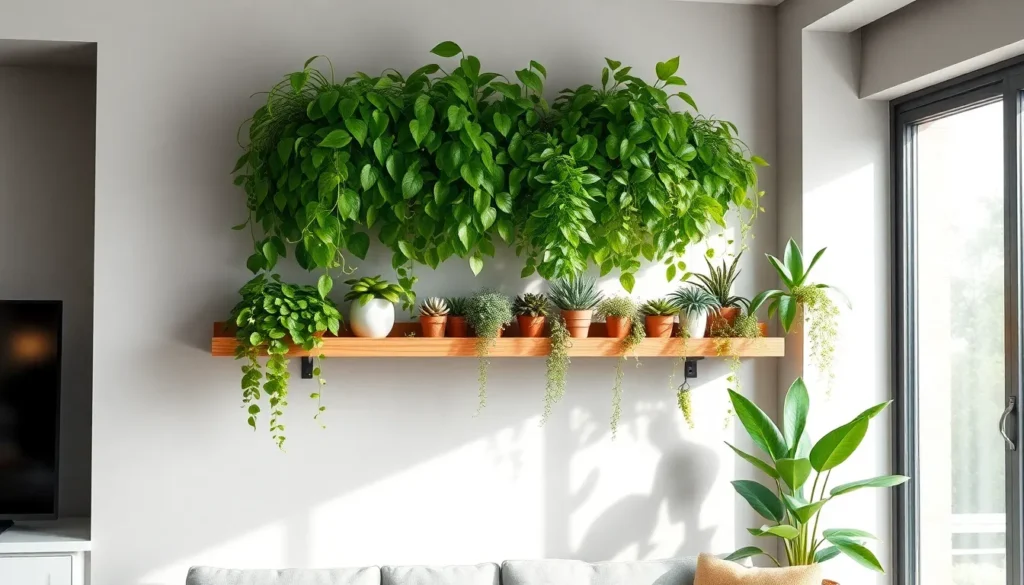Transform any room into a green oasis with floating shelves designed specifically for plants. We’ve discovered that these sleek wall-mounted displays don’t just save precious floor space – they create stunning vertical gardens that breathe life into even the smallest homes.
Whether you’re dealing with limited square footage or simply want to elevate your plant game, floating plant shelves offer the perfect solution. They turn bare walls into living art installations while keeping your beloved greenery safe from pets and curious toddlers. We’ve seen how these versatile displays work beautifully in kitchens, bathrooms, living rooms, and home offices.
The best part? You don’t need to be a DIY expert to create an impressive floating garden. We’ll show you how to choose the right shelves, select plants that thrive in elevated spaces, and arrange everything for maximum visual impact. Get ready to discover why floating plant shelves have become every plant parent’s favorite design secret.
Choose the Right Floating Shelf for Your Plant Display
Selecting the perfect floating shelf determines whether your plant display thrives or becomes a safety hazard. We need to consider several crucial factors that directly impact both the functionality and longevity of our floating plant arrangements.
Weight Capacity and Material Considerations
Wood shelves offer the strongest foundation for heavy plant collections, supporting 20-50 pounds depending on wall mounting quality. Oak, maple, and walnut varieties provide exceptional durability while complementing natural plant aesthetics with their organic grain patterns.
Metal floating shelves typically handle 15-35 pounds and resist moisture damage better than other materials. Powder-coated steel and aluminum options work particularly well in humid environments like bathrooms and kitchens where plants often thrive.
Glass shelves create stunning visual displays but limit weight capacity to 10-20 pounds maximum. We recommend tempered glass versions for safety, especially when positioning shelves above seating areas or walkways.
Wall anchor systems matter more than shelf material in many cases. Toggle bolts and wall studs provide the most reliable support, while drywall anchors alone shouldn’t support more than 10 pounds of combined shelf and plant weight.
Size and Depth Requirements for Plant Containers
Six-inch depth accommodates standard 4-inch plant pots with adequate space for air circulation around containers. This measurement works perfectly for small succulents, herbs, and compact houseplants like pothos or snake plants.
Eight-inch depth provides room for 6-inch pots and allows decorative elements like plant saucers or decorative stones. We find this depth ideal for medium-sized plants such as peace lilies, rubber trees, and fiddle leaf figs.
Twelve-inch depth supports larger planters and trailing plants that need space to cascade naturally. Boston ferns, string of pearls, and hanging varieties benefit from this generous spacing that prevents overcrowding.
Length considerations depend on your plant arrangement goals, with 24-36 inch shelves creating balanced displays for 3-5 plants. Shorter 12-18 inch options work well for single statement plants or small herb gardens in kitchen spaces.
Select the Perfect Plants for Floating Shelf Displays
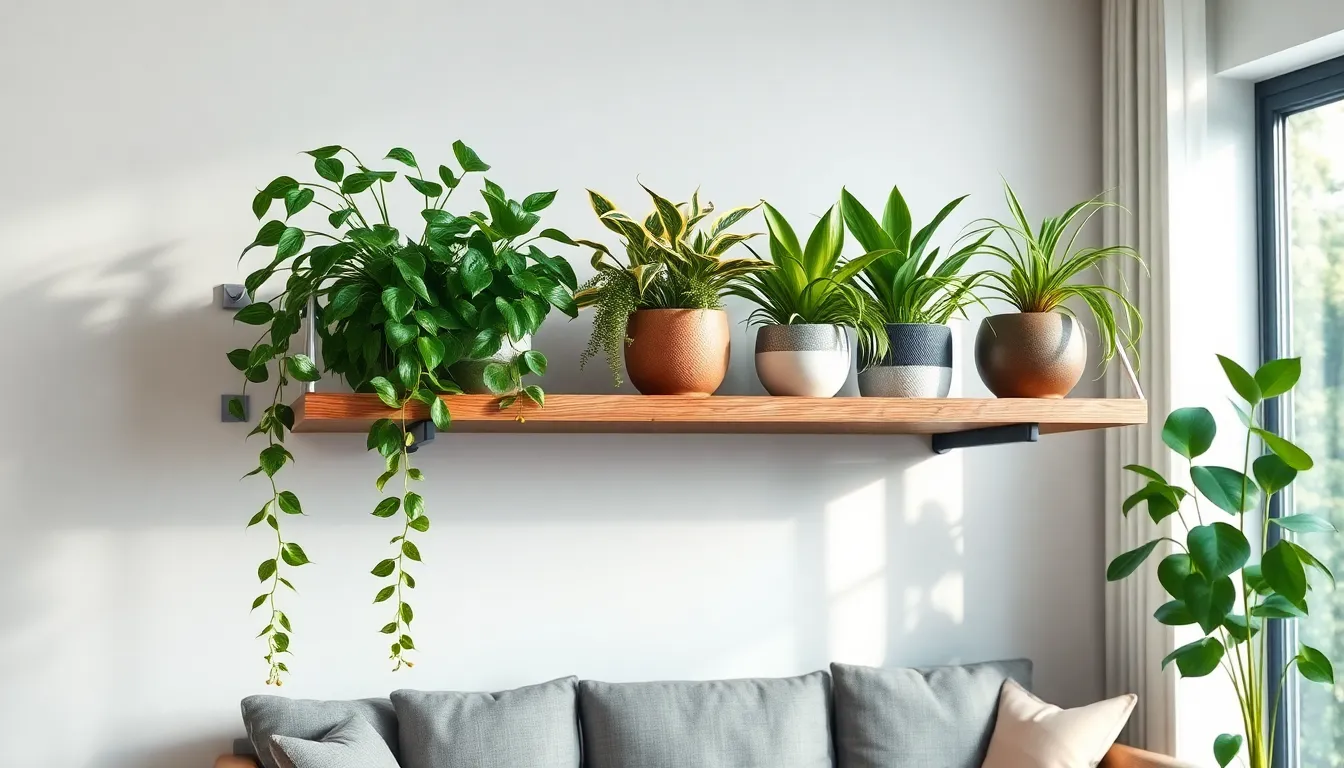
Choosing plants for your floating shelf displays requires careful consideration of size, growth habits, and lighting conditions to ensure both plant health and visual appeal.
Low-Light Plants That Thrive on Shelves
Prayer plants represent one of our top recommendations for floating shelf displays, especially in areas with indirect lighting. Maranta species showcase colorful, patterned leaves and create fascinating nighttime displays when their leaves fold naturally. These plants tolerate partial to low light conditions while requiring consistently moist soil for optimal growth.
Rattlesnake Calathea offers another excellent choice with its striking foliage patterns and compact growth habit. This plant thrives in low-light conditions when watered regularly, making it perfect for shelf placement where natural light might be limited.
Baby Tears brings delicate texture to floating shelf arrangements with its small, spreading foliage. We love how this plant adds visual interest while preferring moist soil and low to partial light conditions that are common in indoor shelf displays.
Snake plants, pothos, philodendrons, peace lilies, ZZ plants, and hoyas round out our list of reliable low-light performers that adapt well to shelf environments.
Trailing Plants for Cascading Effects
Pothos creates stunning cascading displays on floating shelves with their hardy nature and adaptability to low light conditions. Their long vines drape attractively over shelf edges, softening harsh lines and adding natural movement to your display.
Philodendron varieties offer vigorous trailing growth that transforms static shelves into ever-changing living art. These plants tolerate indoor lighting conditions exceptionally well while producing lush, flowing foliage that creates depth and visual interest.
String of pearls provides a unique succulent option with small, bead-like leaves that trail down beautifully from floating shelves. This plant creates an elegant, modern look while requiring minimal maintenance once established.
Trailing plants effectively soften shelf edges and create the lush, flowing visual effects that make floating plant displays feel more natural and lively.
Compact Plants for Small Spaces
Nerve plants excel in tight spaces with their compact size and colorful, intricate leaf patterns that add visual punch without overwhelming smaller shelves. These plants maintain their small stature while providing maximum decorative impact.
Succulents offer incredible variety in compact packages, though they require bright light to maintain their best appearance. We recommend positioning these plants on shelves that receive adequate natural or artificial lighting.
Air plants present unique display opportunities since they don’t require soil and can be creatively mounted or placed in decorative containers on floating shelves. These plants add architectural interest while taking up minimal space.
Compact plant selections allow you to create varied, organized displays without overcrowding your floating shelves, ensuring each plant has adequate space to thrive while maintaining visual balance.
Install Your Floating Shelf with Plants Safely
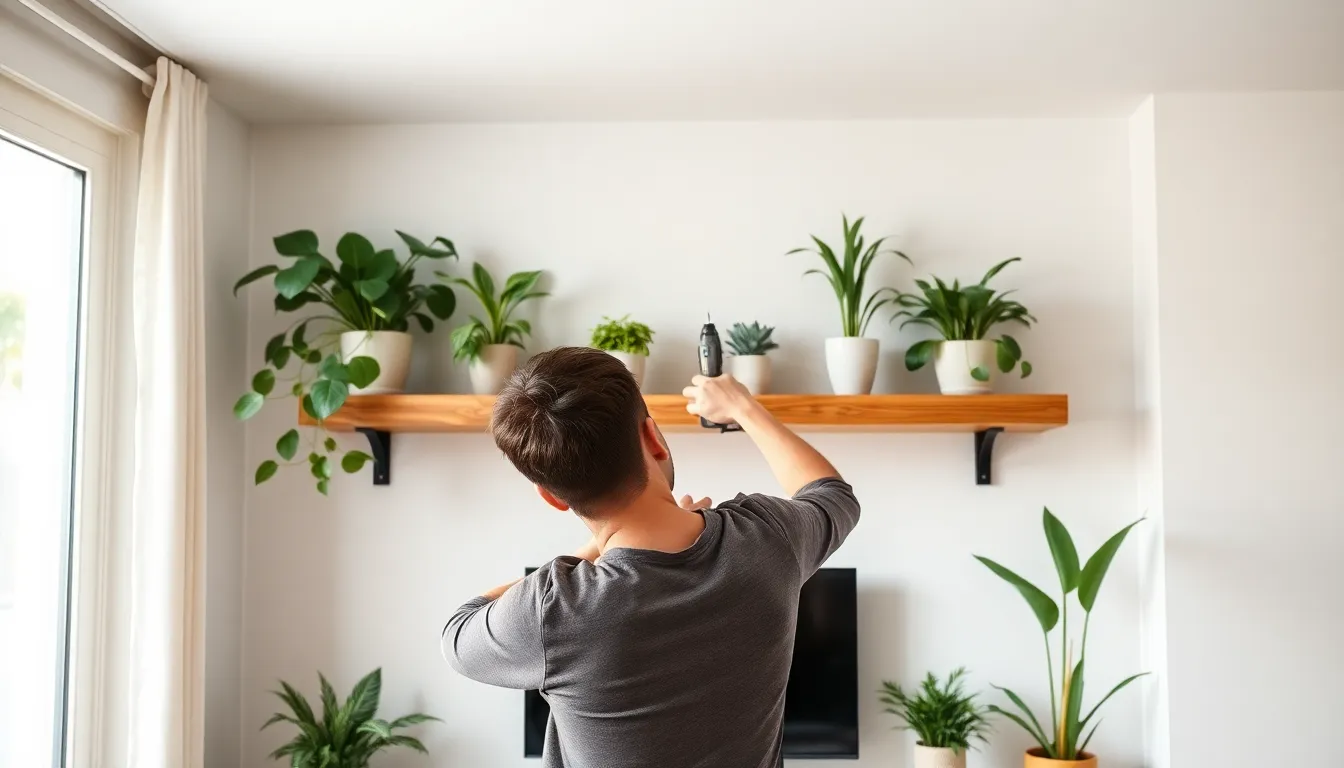
Now that we’ve selected our ideal shelves and plants, let’s focus on proper installation techniques to ensure our floating plant displays remain secure and beautiful for years to come.
Wall Mounting Best Practices
Locate wall studs first using a reliable stud finder because studs provide the strongest foundation for plant-bearing shelves. We can’t emphasize enough how critical this step is for preventing shelf failure under plant weight.
Mark your shelf placement by measuring and drawing a horizontal line where the bracket will align, using a level to ensure perfect positioning. This precise marking prevents crooked installations that compromise both appearance and stability.
Drill directly into studs with a power drill, securing brackets with appropriate screws rated for your shelf’s expected load. Wall anchors alone won’t support the combined weight of multiple plants, soil, and water.
Prepare DIY wooden shelves by cutting boards to size, drilling anchor holes, and optionally sanding surfaces smooth before staining. We recommend installing threaded inserts for stronger screw connections that won’t strip over time.
Assemble all components before final mounting to test fit and make adjustments while everything is still accessible at ground level.
Proper Spacing Between Multiple Shelves
Space shelves vertically with enough room for your tallest plants plus several inches for natural growth and air circulation. Crowded plants struggle with poor airflow and limited light access.
Consider plant mature sizes when determining spacing because small plants today may need significantly more room as they develop. We typically recommend 18-24 inches between shelves for most houseplants.
Plan for maintenance access by ensuring you can comfortably reach each shelf for watering, pruning, and plant care without straining or disturbing other plants.
Account for trailing varieties that will cascade downward, requiring extra vertical clearance below each shelf to prevent tangling or crowding.
Safety Considerations for Heavy Plant Loads
Check weight capacity ratings for both brackets and wall anchors before loading shelves with plants, soil, and decorative pots. Overloaded shelves pose serious safety risks to people and property below.
Anchor exclusively in studs rather than relying on drywall anchors alone when supporting plant collections. Even heavy-duty wall anchors can fail under the ever-changing loads created by watering and plant movement.
Choose sturdy materials like hardwood or reinforced metal brackets for supporting multiple or large plants. Some floating plant shelves feature reinforced backboards and threaded inserts specifically designed for heavier loads.
Add supplemental support with decorative hooks or hanging hardware beneath shelves to distribute weight more evenly across the wall structure. This backup support system provides additional security for valuable plant collections.
Test installation thoroughly by gradually adding weight and checking for any movement, sagging, or wall damage before placing your full plant display.
Design Stunning Plant Arrangements on Floating Shelves
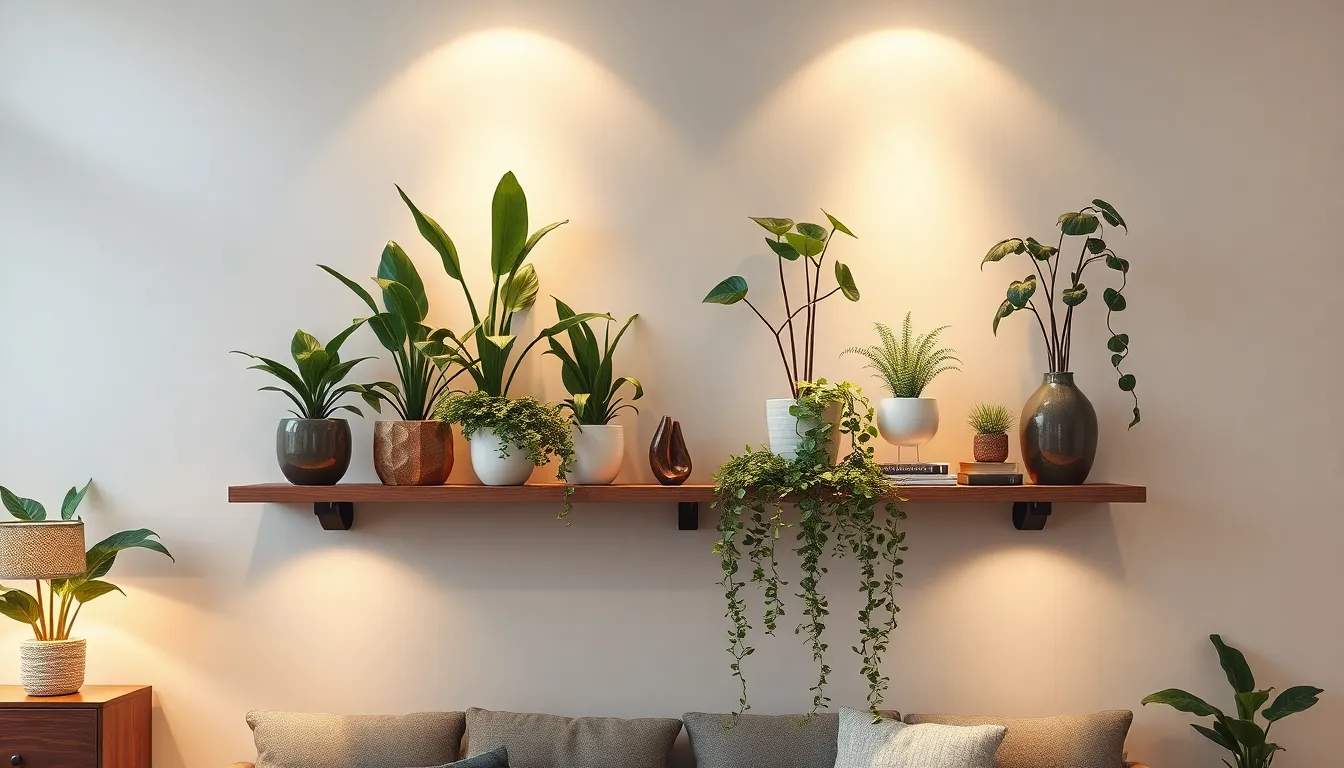
Transforming your floating shelves into captivating displays requires thoughtful arrangement strategies that maximize visual impact. We’ll show you how to create professional-looking plant arrangements that turn simple wall-mounted shelves into stunning focal points.
Creating Visual Balance with Different Plant Heights
Staggering plant heights creates the foundation for visually appealing floating shelf displays. Position taller plants toward the back or center of each shelf while placing smaller or trailing varieties along the front edges and corners. This layered approach prevents visual clutter and guides the eye smoothly across your arrangement.
Symmetrical groupings work beautifully when you want to create calm, orderly displays. We recommend using even numbers of plants and framing decorative objects for a balanced look that feels intentional and peaceful.
Asymmetrical arrangements offer more ever-changing visual interest through irregular spacing and varied plant sizes. Grouping plants in odd numbers while mixing different shapes and heights creates forest-like scenes that feel naturally flowing and eye-catching.
Depth variation becomes crucial for preventing flat, one-dimensional displays. We suggest positioning plants at different depths on each shelf rather than lining them up in a straight row, which adds dimensional richness to your arrangement.
Color Coordination and Texture Mixing
Leaf color combinations create striking visual contrast when you pair lush green foliage with plants featuring different hues. Mix glossy dark green leaves with silvery succulents or burgundy prayer plants to add richness and depth to your displays.
Textural variety transforms simple plant collections into captivating tactile experiences. Combine smooth, glossy philodendron leaves with fuzzy African violet foliage or rigid snake plant blades to create compelling contrasts that invite closer inspection.
Container coordination ties your entire arrangement together through thoughtful pot and planter selection. We recommend choosing vessels that complement your plants while considering color, size, material, and finish to either unify or strategically contrast your display elements.
Foliage shape mixing adds visual dynamism by combining broad-leafed plants with spiky varieties and trailing vines. This approach creates natural movement and prevents monotonous arrangements that lack personality.
Incorporating Decorative Elements with Plants
Decorative object integration elevates plant displays beyond simple greenery collections. Add small artworks, sculptures, or carefully selected books between plant groupings to create curated vignettes that reflect your personal style while maintaining visual balance.
Lighting enhancement transforms floating shelf displays into dramatic focal points through strategic illumination. Install grow lights to support plant health while adding ambient shelf lighting that highlights your arrangements and creates warm, inviting atmospheres.
Functional accessories serve dual purposes by supporting plant care while adding visual interest. Group plants with similar light and humidity requirements together, then integrate tools like small humidifiers or attractive misting bottles nearby for easy maintenance access.
Personal style expression becomes possible when you thoughtfully mix plants with decorative accents that showcase your aesthetic preferences. Balance is key – we suggest maintaining a 70/30 ratio of plants to decorative elements to keep your displays feeling naturally abundant rather than cluttered.
Maintain Your Floating Shelf Plant Collection
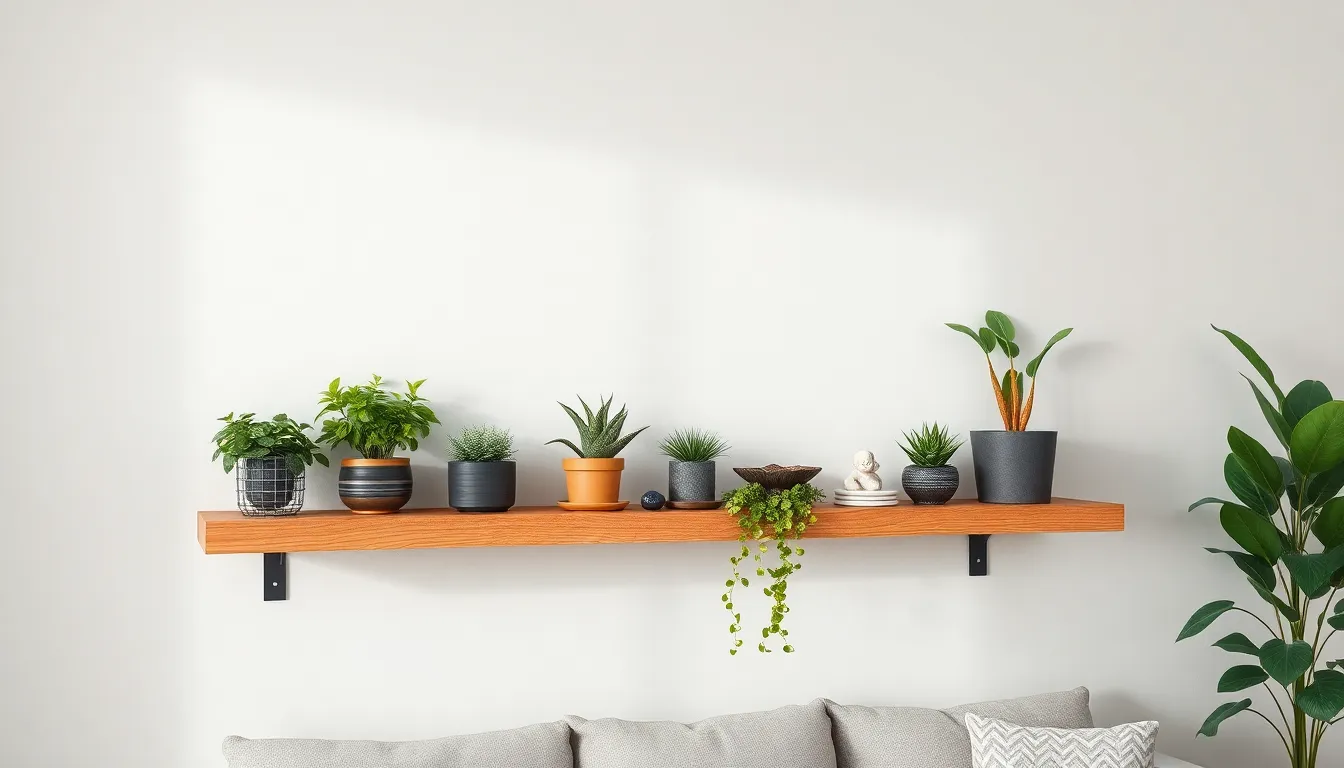
Proper maintenance ensures your floating shelf plant display stays healthy and beautiful while protecting your walls from damage. We’ll guide you through essential care techniques that keep your plants thriving and your investment secure.
Watering Techniques to Prevent Wall Damage
Place small saucers or plates under each pot to catch excess water before it reaches your shelf or wall. Water damage can cause stains, warping, and structural issues that are expensive to repair.
Water plants in your sink when possible and allow complete drainage before returning them to the shelf. This method prevents standing water from accumulating in decorative containers and protects your wall surface.
Use absorbent mats or long trays beneath multiple plants to contain spills across the entire shelf. These protective barriers catch drips and overflows that individual saucers might miss.
Consider pots without drainage holes for your floating shelf display, but monitor soil moisture carefully to prevent root rot. Check the soil regularly and avoid overwatering by letting it dry between sessions.
Install your plants in decorative containers after watering them thoroughly in standard nursery pots. This double pot method gives you the aesthetic appeal you want while maintaining proper drainage control.
Rotating Plants for Even Growth
Rotate your plants every few days to ensure all sides receive equal light exposure. Plants naturally grow toward light sources, creating uneven, sparse growth on shadowed sides.
Turn plants each time you water them to establish a consistent care routine that promotes balanced development. This simple habit prevents your plants from becoming lopsided or losing leaves on darker sides.
Reduce rotation frequency once trailing plants establish their cascading growth pattern. Established vines and trailing varieties need less frequent turning as they develop their natural draping form.
Monitor plant response to rotation by watching for new growth patterns and leaf orientation. Plants that receive even light exposure develop fuller, more attractive shapes that enhance your shelf display.
Seasonal Care and Plant Replacement
Adjust watering frequency based on seasonal changes in temperature, humidity, and daylight hours. Plants typically need less water during cooler months when growth slows and evaporation decreases.
Consider light requirements relative to your shelf placement and available seasonal sunlight. Some plants thrive in minimal light conditions while others require direct sun exposure for optimal health.
Prune or replace plants when they outgrow your shelf space or show signs of decline like yellowing leaves or stunted growth. Regular assessment keeps your display looking fresh and prevents overcrowding.
Incorporate colorful and textured plants to refresh your display with seasonal interest throughout the year. Switching out a few plants creates visual variety without completely redesigning your arrangement.
Add decorative stones and accessories to complement your plant aesthetics and enhance your indoor floating garden’s visual appeal. These elements can bridge seasonal transitions while maintaining design continuity.
Style Your Floating Shelf with Plants for Different Room Aesthetics
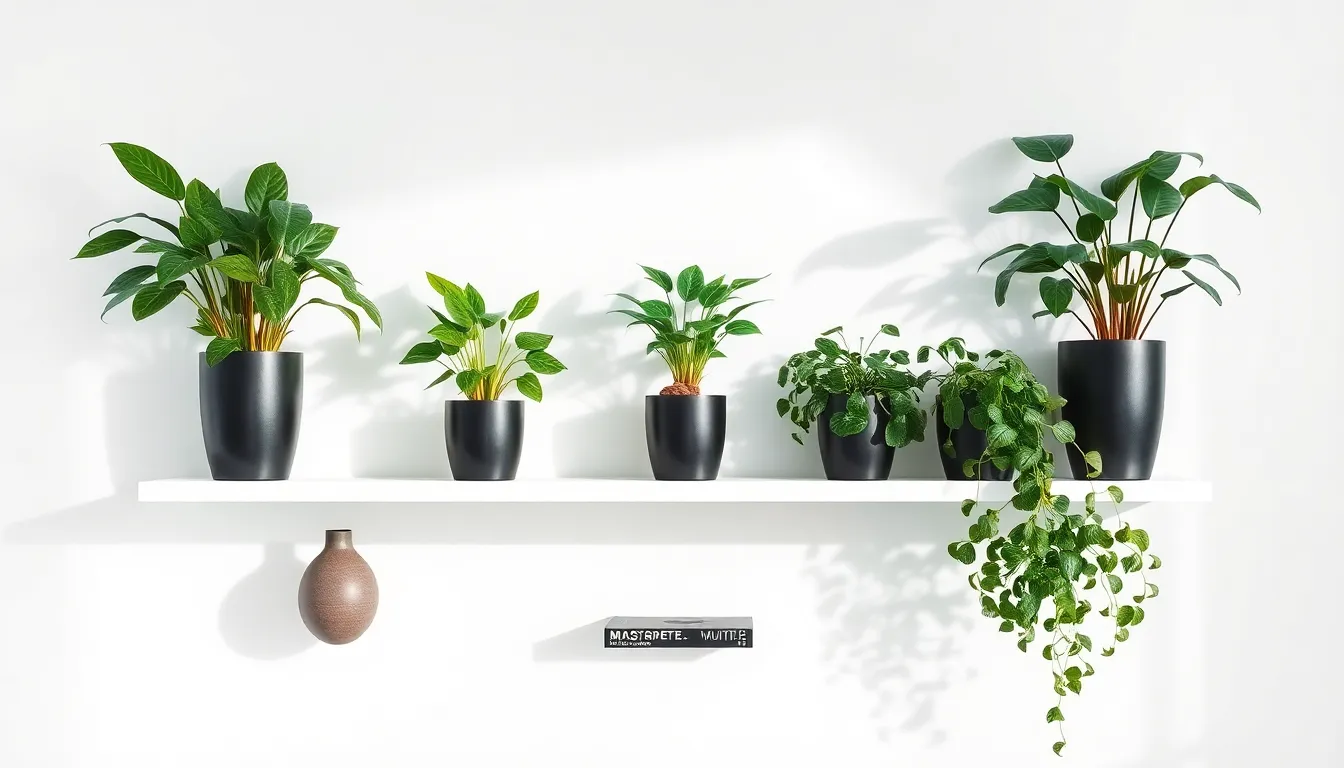
Transform your floating shelf displays by adapting them to match your room’s unique design style. We’ll explore three popular aesthetic approaches that showcase plants beautifully while maintaining visual coherence.
Modern Minimalist Floating Shelf Designs
Sleek, simple floating shelves with clean lines form the foundation of modern minimalist plant displays. We recommend selecting neutral colors like white or black that won’t compete with your plants for attention. Choose plants with architectural forms and varying textures, such as snake plants, pothos, or ZZ plants to add visual interest without creating clutter.
Arrange your plants strategically by mixing trailing varieties like pothos with upright species for balanced visual weight. Keep the shelf uncluttered while incorporating minimal decorative elements like small sculptures or carefully selected books. This approach maintains the clean, modern vibe that defines minimalist design.
Balance becomes crucial when working with fewer elements, so we suggest spacing plants evenly and leaving breathing room between each piece. Consider the negative space as part of your design rather than area to fill.
Bohemian and Eclectic Plant Arrangements
Natural wood shelves or unique geometric shapes like hexagons complement the free spirited nature of bohemian style. We love mixing various plant types and textures in boho arrangements: trailing vines, leafy tropicals such as prayer plants and calathea, plus flowering varieties create ever-changing visual layers.
Layer plants of different heights while incorporating pots with colorful or patterned designs that reflect your personality. Pair your green friends with eclectic decor accessories like macramé hangers or vintage finds to enhance the collected over time aesthetic.
Embrace the “more is more” philosophy by clustering plants in odd numbered groups and mixing pot materials from ceramic to woven baskets. We find that combining plants with personal treasures tells your unique story through the display.
Farmhouse and Rustic Styling Options
Rustic wooden floating shelves, preferably made from reclaimed wood or featuring weathered finishes, anchor farmhouse plant displays perfectly. We recommend using terracotta pots or rustic style containers that emphasize the earthy, cozy atmosphere central to this aesthetic.
Select greenery like peace lilies, philodendrons, or ZZ plants that complement the natural, unpretentious farmhouse vibe. Combine your shelves with authentic farmhouse decor items such as vintage candles, well worn books, or meaningful family heirlooms to complete the look.
Consider the patina and wear patterns when selecting both shelves and containers, as these imperfections add character rather than detract from the overall design. We suggest positioning your displays where they’ll receive medium to bright indirect light, which works well for most farmhouse friendly plant varieties like calathea and snake plants.
Troubleshoot Common Floating Shelf Plant Problems
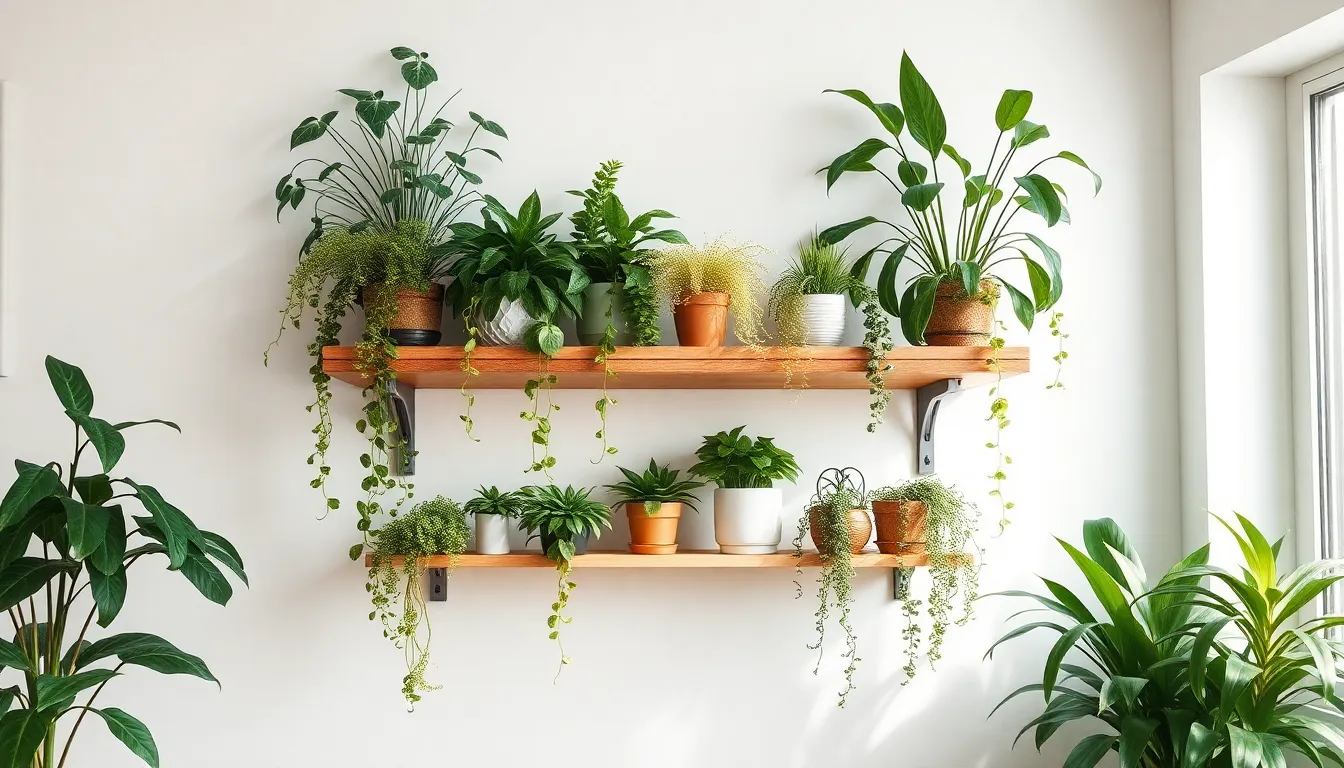
Even with proper planning and care, floating shelf plant displays can encounter issues that need quick answers. Let’s explore the most common problems you’ll face and how to resolve them effectively.
Addressing Water Damage and Staining
Water damage happens when plant pots leak or overflow during watering sessions. We recommend placing a saucer or small plate under every plant pot to catch excess water and protect your shelf surface from stains and warping.
Narrow shelves present unique challenges since standard saucers won’t fit properly. Absorbent mats or waterproof trays work as excellent alternatives to prevent water from dripping onto shelves or items below. These answers keep your walls and furniture safe from water damage.
Drainage holes in pots can cause spillage issues on floating shelves. Consider using pots without drainage holes for shelf displays, but remember to water carefully since excess water can’t escape. Monitor soil moisture levels closely to prevent root rot from overwatering.
Watering shelf plants in nursery pots offers another effective solution. Remove plants from decorative planters, water them thoroughly in your sink, and allow complete drainage before placing them back into their watertight containers.
Managing Overgrown Plants on Shelves
Overgrown plants quickly overcrowd floating shelves and create messy, unbalanced displays. Regular pruning maintains proper plant size while encouraging healthy new growth patterns. Trim back excessive foliage to keep plants proportional to your shelf space.
Trailing and cascading plants need special attention to maintain their aesthetic appeal. Rotate these plants occasionally so all sides receive adequate light exposure, promoting even growth throughout the entire plant. Once established, allow them to cascade naturally without frequent disturbance to preserve their flowing appearance.
Growth patterns change as plants mature on shelves. Monitor plant development regularly and relocate specimens that outgrow their designated space. Moving oversized plants to floor locations or larger areas prevents overcrowding and maintains visual balance.
Seasonal growth spurts can quickly transform well arranged displays into chaotic collections. Schedule monthly assessments of your floating shelf gardens to identify plants needing pruning or repositioning before they disrupt your entire arrangement.
Dealing with Pest Issues in Elevated Gardens
Spider mites and aphids commonly affect indoor plants positioned on floating shelves. Healthy plants resist pest infestations better than stressed specimens, so maintain proper watering schedules and adequate light exposure for all your elevated garden plants.
Regular inspections help catch pest problems before they spread throughout your collection. Check leaves weekly for signs of webbing, sticky residue, or visible insects that indicate active infestations. Early detection prevents minor issues from becoming major problems.
Isolate affected plants immediately when you discover pest activity. Remove infested specimens from your floating shelf display to prevent pests from spreading to neighboring healthy plants. Treat isolated plants with insecticidal soap or neem oil, ensuring these products are safe for indoor use.
Air circulation around floating shelf plants reduces pest problems naturally. Position shelves away from corners and ensure adequate spacing between plants to promote airflow. Good ventilation discourages pest establishment and supports overall plant health.
Daily rotation of plants helps identify pest issues early while ensuring even light distribution. Turn each plant slightly every few days to expose all sides to sunlight and prevent one sided withering that weakens plants and makes them susceptible to infestations.
Soil management plays a crucial role in pest prevention. Allow soil to dry out between watering sessions to avoid root rot and overwatering problems that stress plants and attract pests to your floating shelf displays.
Conclusion
We’ve shown you how floating shelves can revolutionize your plant display game while maximizing your living space. From selecting the right shelf materials to choosing plants that thrive in your lighting conditions these wall-mounted gardens offer endless possibilities for creativity.
Remember that success comes down to proper installation and regular maintenance. With the right approach you’ll create stunning vertical displays that not only look amazing but also keep your plants healthy and happy.
Whether you’re going for modern minimalist vibes or bohemian flair floating plant shelves adapt to any style. Start small with a few carefully chosen plants and watch as your green oasis grows into something truly spectacular.
Frequently Asked Questions
What are floating plant shelves and how do they benefit small spaces?
Floating plant shelves are wall-mounted displays that hold plants without taking up floor space. They transform any room into a green oasis by creating vertical gardens, making them perfect for small homes, apartments, and tight spaces like kitchens and bathrooms.
Do I need to be a DIY expert to install floating plant shelves?
No, you don’t need extensive DIY skills. The key is choosing the right shelves for your wall type, locating wall studs for secure mounting, and using appropriate screws. Following basic installation guidelines ensures safe and stable plant displays.
What materials are best for floating plant shelves?
Wood shelves are ideal for heavy plant collections due to their strength. Metal shelves offer modern aesthetics and good weight capacity, while glass shelves work best for lightweight plants. Consider your plant collection’s weight when selecting materials.
How do I choose the right plants for floating shelf displays?
Select plants based on size, growth habits, and lighting conditions. Low-light plants like pothos and philodendrons work well indoors. Trailing plants create cascading effects, while compact varieties like succulents fit small spaces perfectly.
What’s the proper spacing between floating plant shelves?
Allow 12-18 inches between shelves to accommodate plant growth and provide easy maintenance access. This spacing prevents overcrowding, ensures adequate air circulation, and allows trailing plants to cascade naturally without interference.
How can I prevent water damage to my walls from plant watering?
Use waterproof saucers under all plants to catch excess water. Water plants in the sink when possible, and use absorbent mats for extra protection. Allow proper drainage and avoid overwatering to prevent wall staining or damage.
What are the best design strategies for arranging plants on floating shelves?
Stagger plant heights with taller varieties in back and shorter ones in front. Mix different textures and colors for visual interest. Consider asymmetrical arrangements for dynamic displays, and incorporate decorative elements like small artwork or books.
How do I maintain healthy plants on floating shelves?
Rotate plants regularly for even growth, adjust watering based on seasonal changes, and prune overgrown plants. Inspect regularly for pests, ensure good air circulation, and replace plants as needed to maintain attractive displays.
What common problems should I watch for with floating plant shelves?
Monitor for water damage, pest infestations, and overgrown plants. Use proper drainage systems, maintain good air circulation, and prune regularly. Check shelf stability periodically, especially as plants grow heavier over time.
How can I style floating plant shelves to match my room’s decor?
For modern minimalist spaces, use clean lines with simple plants like succulents. Bohemian styles work well with trailing plants and mixed textures. Farmhouse rustic themes pair beautifully with wooden shelves and traditional plant varieties.

